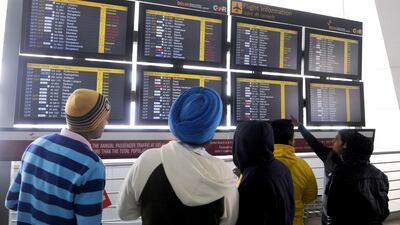A bid to remove a limit on the number of airline seats between India and the UAE could turn the Emirates into a "weekend getaway" for millions of Indian families, boosting a key sector of the economy in the process.
Travel industry experts predict lower fares and a major boost if the current agreed capacity - 130,000 seats per week - is lifted later this year. Emirati and Indian officials are set to meet in October to discuss the move.
On Wednesday, the UAE ambassador to India, Dr Ahmed Abdul Rahman Al Banna, said more flights "will lead to affordable prices".
The agreed number of seats between the two countries is currently at 100 per cent capacity, WAM reported. With a population of more than 1.2 billion, India has huge scope for increasing travel demand.
Nishant Pitti, the chief executive of EaseMyTrip.com, which has an office in Dubai, said cheaper flights could turn the UAE into “a popular weekend getaway for Indian travellers”, for families for whom that currently isn't an option.
“The UAE is an important tourist destination for Indian travellers,” said Karan Anand the head of relationships at Cox & Kings, one of the oldest travel companies, headquartered in Mumbai. “More flights means less cost.”
He said that the UAE's proximity to India is a factor that makes it a popular option for Indian tourists, while “it has the look and feel of a world class tourism destination that is attractive to families”.
In particular, there is enormous scope to add more flights connecting India's smaller “tier two” cities to the UAE and boost tourism numbers, he said.
_________________
Read more:
UAE proposed talks to increase flights from India and cut air fare prices
Dubai's theme parks look to Indian visitors for boost
_________________
An increase in flights could lead to an increase for tourists visiting Sharjah and Ras Al Khaimah, said Vineet Gopal, the managing director of Representation World.
“With an increase in the flights, new avenues of business will also open up, thus increasing footfall from India market,” he said.
“The demand is increasing every year, thus there is a need of more fights on this route.”
About 1.8 million Indians visited Dubai last year, making it the emirate's largest market for tourists, according to figures from Dubai's Department of Tourism and Commerce Marketing. India was also the largest overseas market for Abu Dhabi last year, with the number of hotel guests from India up 15 per cent on the previous year to 323,000 guests.
Numbers from early 2017 show that Etihad Airways and Mumbai-based Jet Airways – in which Etihad holds a 24 per cent stake – together operate 280 flights a week between Abu Dhabi and 18 cities in India, including Ahmedabad, Mumbai, and Kochi. Emirates Airline, meanwhile, operates more than 180 flights between Dubai and India.
Fahad Khateeb, who is based in Mumbai and owns an LED lights manufacturing business, travels to Dubai at least once or twice a year, for both business and leisure.
“What I like most about the UAE is the infrastructure and the business opportunities, along with the ease of doing business,” he said.
He said he would definitely travel more frequently to the UAE if prices of flights were to come down.
Return flights between Dubai and Mumbai, for example, can often be found selling at just over US$200.
“Prices are already very competitive, but low cost airlines do not provide a quality experience. If prices for the likes of Emirates come down a little more, it would do wonders, especially for the business community.”
The number of Indian visitors to the UAE rose by 9 per cent last year to 2.3 million compared to 2015, making up 8.5 per cent of the country's total visitors, according to the UAE Ministry of Economy.
Trade ties between the two countries have been historically strong and Indians make up the largest single nationality of expatriates in the UAE.
Both countries are keen to boost their economic ties, with Sheikh Mohammed bin Zayed, Crown Prince of Abu Dhabi and Deputy Supreme Commander of the Armed Forces earlier this year travelling to India to be the chief guest at the country's Republic Day celebrations.
Mr Al Banna, the UAE ambassador to India, met Jayant Sinha, India's minister of state for civil aviation, and discussed air routes between the two countries.
He raised the point of adding more flights to connect regional airports in India and brought up the need for “an open sky policy that gives an immense potential towards enhancing India-UAE ties”.
“Both the parties agreed to set up the meeting between the general civil aviation authority of UAE and civil aviation authority of India to propose the new agreement and policy for the bilateral air service agreements in October 2017,” according to the embassy.
UAE airlines over the years have been outspoken about the fact that they are being held back from expanding in India because of limitations on seats and have called for bilateral rights to be liberalised.
UAE carriers are also eager to expand their flights to India because it is an important market to feed Indian travellers to long haul destinations including Europe and North America.
But analysts warn that while consumers could benefit from cheaper fares, the move would not be everyone's advantage.
“It will badly hit the margins of Indian carriers, which are making losses on international routes like the Middle East,” said Archit Gupta, the chief executive of Atom Aviation Services in Delhi.

